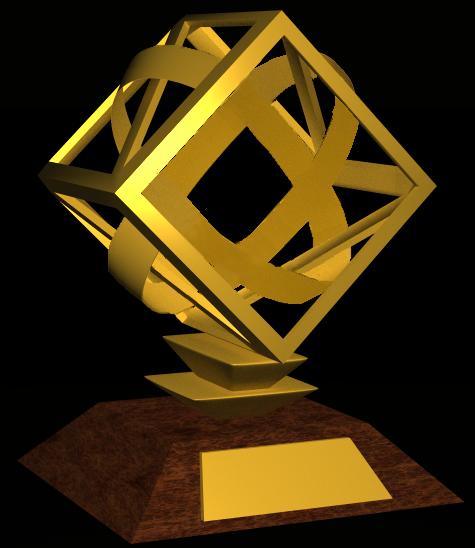Adventure: Welcome to the Genre - Extras
Here's my collection of behind-the-scenes info on Adventure: Welcome to the Genre. If you haven't finished that game, don't read any further unless you want the game to be spoiled for you!
General Info:
I worked on this game almost daily for over a year, then suddenly I started to lose my focus and motivation, and slipped into a state where I couldn't even look at the game for many months. I could barely do anything creative during that time and was in a pretty bad place mentally. I finally felt confident to look at the game again in September 2017, and I've forgotten a lot about what I've put into the game and my thoughts behind the game's creation, so it's going to be a bit tricker to elaborate on those parts of this game's history.
One of my goals going into this game was wanting to slightly parallel some of the plot elements from Thalia's original cancelled game, which included her accidentally swapping minds with another entity, getting help from her nephew Dylan, voluntarily swapping minds with a few other animals and eventually using her new ability to save herself towards the end of the game. Even the robot puzzle on Lasol VII is a variation of a puzzle I planned on using in her original game (this puzzle, incidentally, is a homage to Robert Sheckley's short story, "The Cruel Equations").
Since I wanted this game to be the last one in the series, I felt it would be appropriate to make a number of callbacks to elements from the first game (Thalia's room, Suzy-Ann, Sidonius and his game) to give more of a sense of closure. It was also a fun challenge to expand on things only briefly touched on in the first game, like Suzy-Ann's game, Thalia's game, and Dylan.
The book excerpt in the intro was added very late in the game's production. I didn't want to dump a wall of text on top of an already somewhat lengthy intro, but given how much of this series and adventure games there is to unpack, I felt like there had to be something at the very start of the game to give the players an idea of what they were in for before launching into the conversation between Thalia and Dylan.
I originally planned for Thalia's first time in the beast's body to be a short playable segment set in Space Quest II, where Thalia's objective is to get back to her body by leaving the cliff via a small path on the right side of the screen, then jumping the chasm once she gets to the top and swinging across the swamp on branches. I decided that this would be way too much work for very little gameplay, plus the idea of Thalia wanting to get back to her body (rather than staying where she was and just "waiting it out") doesn't really make much sense.
The mindwapping effect took a while to figure out how to do. I looked at several AGS modules and eventually wound up modifying monkey_05_06's Magnifier module to use a series of almost completely transparent sprites to slightly "warp" the background they appeared over. This proved to be a bit difficult since I couldn't create an animation of the mindswapping and had to display each individual sprite manually one after the other and they had a bad habit of appearing in the wrong location for no obvious reason, but I think the end result was worth it.
Usually, the words in Sledge's vocabulary can be classed as one of three things: A) A distortion of an existing word, B) a word taking the place of an existing word with a few similarities, or C) a completely random, made-up word.
screwbs: a shortened version of "screwballs"
zwang: mess with, confuse
preflobes: brain (a mangled version of "pre-frontal lobes")
zingo: bingo (i.e., "correct")
whompin': equivalent to "cool," "awesome"
The plot element about high-res characters being unable to make out details in low-res graphics started out as a brief exchange between Thalia and the Manhunter extra in Adventure: All in the Game. I was glad I was able to make an actual puzzle out of that idea in this game.
The CommKey's interface has become progressively smaller throughout this series in an attempt to make the room-to-room transitions as streamlined as possible. The shortcut to the Mega-Game's doorway was a feature added very late in the game's production, since I realized that having only one doorway in that game meant a lot of walking if the player wanted to leave the Mega-Game and was several rooms away from the doorway. I was considering coming up with a map GUI that would teleport the player to locations they already visited (a la King's Quest III), but that presented some problems (especially with the canyon, where the teleportation feature would nullify how long the canyon was if the player could just teleport to the theatre), so I felt that letting the player teleport back to the doorway was a fair compromise.
I also wanted to include the same "spacebar+left mouse click" teleportation system I used in All in the Game, but for some reason, that code wouldn't work on the laptop that I was using to work on the game when it was close to being done, so I figured that instead of implementing some code that probably wouldn't work on some people's machines, I'd just leave it out altogether.
Being able to take only one item from the tech room at a time was loosely inspired by the pawn shop in King's Quest VI, just as the second piece of fruit being available to you if you don't take the fruit from Lemort's office is loosely inspired by the availability of the flowers in King's Quest VII.
The animation of Dylan playing a VR game using a wireless headset was created several years before such a thing became a reality.
The black band on Dylan's wrist was originally just added as a random accessory, but I later decided that it had to be an anti-static wristband. Given how much time he spends around electronics, it just made sense.
Dylan's line about blasting tenth-dimemsional monstrosities back to their own world was another last-minute addition. His original line was "blowing up virtual monsters is entertaining only for so long", but late into the game's production, I was watching/listening to a lot of YouTube videos featuring first-person shooters, and I started thinking of ideas for FPS's that would involve eliminating targets, but not actually killing them -- another small detail that could possibly shed a bit more light on what Thalia's world is like. A weapon that transported targets to another dimension was one idea that I decided to implement here. Also, "taedios" is a Latin word meaning "disgusting."
If you look at the menu in the Vertex's lounge, Thalia notices that Quogburgers are on it. This is a reference to a fictional artificially-grown meat which is mentioned in my first game, Area 50.5. The red, radio-like device from Area 50.5 also makes a cameo on one of the shelves in the knick-knack shop.
The music piece Thalia tracks down is the opening music to the old-time radio show Quiet Please, a series which contained many suspenseful, chilling stories, some of which broke the fourth wall in truly surprising ways. The way the music is used in AWTTG is a reference to the climax of an episode of "Quiet Please" called (surprise!) "Symphony in D Minor". In it, a woman is cheating on her husband (a blind psychologist), and her lover is plotting to kill her husband. He eventually succeeds...but not before the psychologist hypnotizes the woman, telling her to shoot her lover when she hears the musical piece "Symphony in D Minor".
Believe it or not, even though Sidonius brings up the idea that the adventure game genre's Administrator is a character from a text-based game in the first game in this series, I had no idea who the Administrator should be until I started working on this game. The dragon turned out to be perfect for the role: it's in a hidden place in a seldom-played game (all the more time to dedicate to its job), its game is very old (meaning it has had a lot of time to gather knowledge about the genre), the character's a freaking dragon, and when it comes to early adventure games, it's hard to get more iconic than the game Adventure.The setup of the Administrator's Room did get somewhat close to that text adventure section in Sam & Max Season 1, Episode 5, but I suppose that similarity was unavoidable.
A character with an illness that made them involuntarily change resolutions was an idea that came to me early in the game's production that originally wasn't anything more than a one-time gag (I didn't even have a character in mind for some time), but the idea of Chu later holding Alexander hostage only to have his illness save him not only provided a satisfying payoff, but also mirrored Thalia's own situation.
Even though I'm still no good when it comes to composing music, I did a lot of playing around with the many free music tracks available online in order to get just the right sound to go with a particular scene. MIDIs were especially fun to work with, since I could associate different instruments with the various tracks. For instance, the track used on the tar pits screen was a MIDI that used acoustic, fingered bass, picked bass and electric piano as its instruments, but replacing those instruments with melodic tom, pan flute and marimba samples from a pretty good soundfont in LMMS created a nice, "primitive" sound which was a perfect fit for that scene. The track that plays in the mini-game after you ask the NPC is a slightly altered version of the track that plays when you first start playing the mini-game, and when you first enter the valley where the Grand Theatre is located was one of the only pieces of music I created (if you can call it that) with the piano tones accompanying the sparkles on the crystals acting as a subtle homage to Sierra's classic logo animation.
The examples of Outsider literature Sledge mentions (Ringworld and Sherlock Holmes) aren't completely random choices, since he comes from a science fiction game (Ringworld is science fiction) and helps solve a minor crime in Adventure: All in the Game (albiet using some more high-tech techniques than Holmes). And yes, "Go lick a forcefield generator" is a reference to one of the deaths from Space Quest IV.
LeMort's voice (which is only heard over the Cabal's CommKey equivalents) was created from a series of recordings made by my great-grandfather of him and some friends telling risqué jokes. I basically took several samples of their voices, shuffled them around, sped them up and applied a high-pass filter to create that "sped-up phone voice" effect. If you slow down those sound clips to the point where the words are discernable, you won't hear anything but random phrases strung together. Conversely, Loamy's voice is just me making random noises, which were then tweaked slightly before the high-pass filter was applied.
The voice of the dinosaur Thalia swaps minds with is mine with some slight alterations. While I was working on that scene, a pile of large bamboo stalks showed up at the curbside just a couple blocks from my apartment, which made getting sound effects for that scene a lot easier.
"Sparks" Malarkey's name came to me spontaneously as I was making breakfast one morning. I decided to Google the name just to be sure it hadn't been used already. I did find a few instances of "Sparky Malarkey" appearing as the name of a blog and a Twitter account, and though these seemed pretty close to the name I'd come up with, I decided to use it nonetheless. No use letting such a perfect name go to waste.
The name Sparks accidentally calls Thalia when he's talking about the Venties is a Mystery Science Theater 3000 reference. Apollonia James is a main character from one of my favorite episodes, Overdrawn at the Memory Bank.
All of Ichabod's paintings are made by me. The first one is done in watercolors, the second one is a pencil sketch colored digitally, and the other two were done digitally. Only the last two were made specifically for this game, though -- the first two are older, unrelated pieces that I modified slightly.
I didn't make any of R. Kyvist's lines mimic the accent he has in Torin's Passage because I didn't want to make it difficult to understand him (especially with the number of lines he has, some of them of importance to the story).
During my perusal of various adventure games' resource files, I've found several inventory items that either never existed in the final game or had its sprite altered somewhat. Though I do have a small site that documents my findings, the knick-knack shop was the perfect place to display a small handful of these items that I (and others) have discovered.
The heap of pixels in the unfinished Room in the Mega-Game wasn't something I planned to do anything with when I first thought of it, but then I realized that I just couldn't include a heap of pixels in the game and not do anything with them. I didn't come up with an idea about how to use them until several months later: I originally planned to have the artifact be a cup with a picture of a pig on it that Thalia rubs coffee grounds on (from the two construction workers' lunchbox) to make it look older, but the coffee grounds seemed a bit too unconvincing for a puzzle solution (even though it IS somewhat grounded [hah] in reality).The idea for making the cup look more rustic by dipping it in the pixels came out of nowhere, and shortly after I got it, I changed the cup to a figurine, since I realized that a cup might lead some players to thinking that something needs to be collected in it.
Curly's Adventure is one of the few cancelled games mentioned in the Thalia James series that actually exists in the real world. It was being developed by Sylum Entertainment before being cancelled in 1999, although a playable demo of the game still exists.
The Yapok identification puzzle was loosely inspired by a section in the 1996 Mecc game Science Sleuths, Volume 2 where you have to identify a plant by answering various questions about its appearance in order to narrow down what species it is (an identification key, in other words). I don't think I've ever seen a puzzle like this in an adventure game.
The yapok is a real animal, and just about everything you hear about it in the game is true. It's cool. Look it up.
The buildings on top of the cliffs in the scene with the pits are from a photo I took of a piece of architecture near Carpenteria, California (USA). I don't know what that place is, but it does make for some pretty background decoration.
The identities of the two characters sitting on top of the castle was fairly nebulous at first. Having Clem be one of them turned out to be a great idea, because A) It meant bringing him back and elaborating on his character, and B) Him stupidly falling to his death helped to introduce what the Restoring sequence looked like. The barbarian wasn't established as his companion until sometime later, and the completely incompatible personalities the two ended up with made it pretty fun to write their dialogue. (I greatly empathize with the barbarian.)
Having Thalia's inventory items appear as memories while she is in the sea lion's body and unable to carry them with her was inspired by a similar system used in A Vampyre Story.
The disk puzzle that has to be solved in order to retrieve Malcolm's evidence was based on a puzzle using very similar disks in Death Gate (hence why Anita says the Mega-Game's disks were copied from the disks in that game). This gives anyone who might have played Death Gate a good hint to how the disks in AWTTG need to be used.
Thalia's description of the monster in the pit is a Beneath a Steel Sky Reference (Robert Foster describes the monster in the hole in the subway the same way).
Using the Jack-in-the-Box crank to fix the crankless gramophone was loosely inspired by Ben304's short AGS game, ^_^ (yes, that is the actual title).
The jungle background was made by maniplating photos from a trip my mom and I took to Ecuador, the crystals surrounding the theatre were created from photos I took of a small chunk of titanium quartz, and the rock formations that make up the south cliff were created from photos of the same beach I used as a backdrop for the Spindrift Room in Adventure: The Inside Job.
The sound of Charlie producing his web was made by manipulating various-sized wads of cooked spaghetti. Also, I chose "Charlie" as his name because it's the male form of "Charlotte", and anyone even somewhat familiar with E. B. White's stories will understand why I did that. Also, the "spider the size of a Buick" line was a reference to Annie Hall, which I was first introduced to via Mystery Science Theater 3000.
Even though it's too tiny to make out, Charlie's laptop has Adventure's crest on his laptop's cover. The crest also appears much more obviously on the theatre's boxes.
The bird Thalia swaps minds with to get the jacket went through several changes. Initially, it was an osprey, then I contemplated making it the seagull from Loom (which I decided was too small to carry something like a jacket), then changed it to a Stellar's sea eagle (which I may have changed my mind about since there weren't enough pictures and videos of them to refer to), then back to an osprey again.
The 3D section of the game had to be one of the hardest ones to do, and it's not something that I'd want to do again anytime soon. At first, I tried to import an actual 3D character model into AGS, but when that proved to be too complicated for me, I resorted to creating a 2D character that looked 3D (somewhat like Sledge) and placing it in a 3D environment created with Richard Evans' Easy3D Module, which also took some time to figure out. In the pseudo-2.5D scenes (which feature 3D-looking characters on a 2D background), I tried to make the characters seem as 3D as possible by having them constantly moving very slightly and (in the case of Thalia) making them transition into and out of their walk cycles instead of going from a standing pose straight into a walking animation, and vice versa. I did this by making an invisible "dummy character" quickly walk wherever the player clicks the walk cursor and making thalia play a "starting to walk" animation before turning and following the dummy to wherever it ended up, then playing the "stop walking" animation before stopping completely (I ended up scrapping the "start walking" animation because it seemed a bit too awkward).
Even though this section didn't turn out quite as well as I'd hoped, I still think it gets the job done.
The fourth-wall-breaking "P.S." in the Cabal's note was a last-minute addition. I slipped it in because I couldn't think of a more unobtrusive way to tell the player that there is a setting in that room (and only that room) that lets you adjust Thalia's walk speed. I had to add that setting when I realized how different Thalia's speed in the 3D room was on my desktop and laptop computers.
The section in the 3D maze where you have to figure out what the carvings on the pillar are was loosely inspired by one of the last puzzles in Discovery Channel Multimedia's 1995 game, Connections, where you have to pick three heiroglyphics out of a wall filled with them to complete a sequence where each heiroglyph in the sequence is secretly a number butted up against a horizontally flipped version of itself. For the 3D section, I wanted at least one puzzle that was unique to a 3D environment, was not only hard to come up with, but hard to do with little to no knowledge of creating a fully 3D game. The end result, while not being as 3D-specific as I'd hoped, was still reasonably good (not to mention, just as much a of a stumper as its inspiration was for me). I may have also taken a small amount of inspiration from the sequences where you have to move around an environment until the Riddler's symbol shows up in Batman: Arkham Asylum.
The description of Suzy-Ann's armchair is a reference to The Incredible Adventures of Jack Flanders. I didn't plan on making this reference from the start, but when I ended up with a green armchair in Suzy-Ann's room, I couldn't resist.
Suzy-Ann's mini-game was probably the second-hardest challenge for me aside from the 3D section. The interface was done pretty much entirely from scratch, and it made the CommKey's code (which I once thought was fairly advanced for my skill level) seem simple. The code is pretty messy, I had to test the section many times to get things working the way they are now, and I'm still mildly surprised that I was able to pull it off as well as I did.
I really wanted the key you press to get help in the minigame to be "F1", but since that key now brings up Windows Help and Support and I couldn't find any way of disabling that action from within the game, I made the difficult decision to change the key to "1".
The animations of Thalia reforming and the animations of the hole in the theatre were done in Blender. This was the first time I seriously did anything with Blender, since the first few times I tried it, I ended up giving up in frustration. Since I couldn't find any other way to do that particular effect, I decided to give Blender another go, and this time, I was able to push through. (The explosions in the game's finale were also done in Blender.)
The death theme is a shortened, sadder version of the music in the outro of Adventure: The Inside Job, and it was also written by Brandon Blume (thanks again!). It seemed fitting that music from the end of that game should be the music to accompany the end of Thalia's life.
The sound made by the creatures on Lasol VII is a modified barn owl screech.
I intentionally designed Jean-Eric LeMort to be as much of a stereotypical villian as possible. The fact that his first name almost sounds like the word "generic" was not unintentional.
LeMort's comparing the adventure game genre to Thalia was inspired by a quote from a review of Adventure: All in the Game that I found on a site which seems to no longer exist, which reads: "You star as Computer Game Maintenance Squad (CGMS) member Thalia James (whose graying hair and asexual space suit give her a classic appeal befitting of a genre too old and lacking in sex appeal to keep up with the times)."
The creature that opens the door to LeMort's office to escort Thalia away is the troll from King's Quest IV (although it's almost impossible to tell since all you can see is its shadow, which is warped and nigh unrecognizable [not to mention that it's almost impossible to see the troll itself in its own game]).
The Venties trophy is an impossible shape based off of M. C. Escher's print, Cube with Magic Ribbons. Here's a larger version of it:
The canyon arcade sequence is the first arcade sequence ever I've done. At first I wanted it to be similar to the Space Quest I skimmer sequence, but when my attempts to create something like that failed, I went with a much more doable top-down perspective. The randomness of the rocks does make it a bit unfair at times, but fortunately, it is short and skippable.
Not counting Sparks, Charlie and Qoppa (the last two visible in the bottom right), there are approximately 101 adventure game character in the wide angle shot of the inside of the theatre. How many do you recognize? ;)
The art pieces hanging in the theatre's lobby are an idea I was pretty proud of, which was to depict an iconic scene from a game using an artistic medium befitting of that particular game. I created the scene from King's Quest by overlaying a combination of elements from various public domain medieval paintings with pieces from a number of medieval woodblock prints. Loom's piece is (naturally) a tapestry, which I did by overlaying a woven pattern on a modified version of a screenshot from the game.
Some of the screams heard when the grenade explodes include screams from Roger Wilco (an unused voice clip from Space Quest IV), Laura Bow, Bobbin Threadbare, and the Blind Dessert Taste Test attendees from Leisure Suit Larry 7. However, even without any music or sound effects interfering, it's almost impossible to pick them out.
There are a couple character cameos from Adventure: All in the Game in the theatre scene. Qoppa the lemur is visible in the wide angle shot with the stage in the background, and the redheaded farmhand from "The Most Offensive Adventure Game Ever" is in one of the boxes in the background when Thalia is lying on the floor (and of course, he hasn't realized that he should be running away in fear yet).
The game's climax slightly parallels the ending of the third Thursday Next book, The Well of Lost Plots, which features a huge ceremony being held in the Bookworld where various elements and entities of fiction receive awards. Since my memory of when I was first working out the plot for this game is a bit fuzzy, I'm not sure if this was an intentional homage or a coincidence.
In the theatre scene, I initially didn't plan on doing anything with Dylan after he passed out, but then I realized that after how much time Thalia spent trying to figure out what happened to him, there's no way she would just leave him there as she followed the rest of her team to the podium. I ended up spending a couple extra days working on an animation of her dragging him onto the stage just for the sake of character consistancy. Art, man.
Just like in Adventure: The Inside Job, Thalia's physical similarity to Valanice is played up, as she ends up doing something very much like what Valanice does in King's Quest VII (transforming into a jackalope and using its incredible speed to get somewhere in a hurry). As I've mentioned elsewhere, King's Quest VII was the game that really inspired me to start to seriously draw humans, pursue 2D animation, and design games of my own, so I feel obligated to make references to it every once in a while.
Tlotzin and Thalia's "What are you doing?"/"My job." exchange isn't an intentional Die Hard reference, since I never watched Die Hard until December 2015.
Adding Chuck the Plant to the final scene was a last-minute idea. I knew that I wanted to add a plant to that scene, but I didn't think of using Chuck for some time.
Six of the characters in the Vertex during the outro are characters from AGS games. I put out a call for cameos on the AGS forums, and the creators of these characters were the ones that answered it.
The blue cup in the outro is the first time I've included the AGS blue cup in any of my AGS games. Since there was going to be a scene involving AGS Roger, a bar and a toast, not using it would be unthinkable.
When I was unable to find a way of creating the credits that produced a smooth, crisp video, I resorted to the same trick I used for the credits of Adventure: The Inside Job, which was creating a character whose view consisted solely of one huge image containing all the text, then slowly moving that character up. The image of the genre's crest was a second character overlaying the first.Also, since I couldn't find a way of creating a font that was useable outside of AGS out of the game's main font, I had to create the credits by creating a series of 640x480 GUIs with one section of the credits displayed on labels in each one, then copying, pasting and merging the content of each GUI into the credits image I ultimately ended up using. I'm sure there are more tedious methods of creating credits than this, but I can't for the life of me think of any.
One of the top requirements I set for the game's trailer music was that it needed to sound at least vaguely similar to Guns 'n' Roses' "Welcome to the Jungle". I might not have entirely succeeded, but I still think I found a good track.
Cut Concepts and Dialog:
There was originally some dialog between Thalia, Mark, Sledge and Jerrod in the intro:
[after intro, heads peer over bushes] Jer: OW! Watch where you're stepping, Sledge!
S: Sorry.
S: Hey Thal, where's Roger now?
[thal commkey]
T: He's almost through that root monster maze now.
M: Heh...how much you wanna bet that he dies in the next two minutes?
T: Shush, Mark.
[pause]
T: Okay, he's out -- and he's headed this way!
Everybody hide!
[they hide, roger enters from l, leaves to right]
J: All right...when he gets up here, I'll open this back panel. You know what you've got to do, Sledge?
S: Grab the "free whistle" form he slips in and drop the "non-free whistle" form into that vortex at the bottom.
J: You got it. Now let's hunker down and wait for him to...
[thal com]
T: Wait, Jerrod -- I think he's going back to the crash site.
M: *Sigh*...
T: Yes, he is. Now he's going towards...the...
[pause, change in music?]
[At that moment, a strange sensation came over me. As foreign as it felt, I KNEW what that sensation was...and this knowledge made me do something that I would never have done otherwise...]
T: I...I'm sorry, guys...I don't have time to explain, but I've got to get out of here!
[runs to r, others shout out in unison]
J: Thalia!
M: What the heck!?
S: Where are you going??
Here's a collection of concepts which were either changed or scrapped:
*The reason she is swapping minds with characters in her game is because the device is only doing what it was meant to do in the context of the game -- it doesn't function with anything outside the game that isn't part of it.
-one of the villians left a lo-res note in the admin's room -- it doesn't show up until Thalia asks the admin whether he has heard anything about the genre's current problem.
the admin can't help thalia look at the object left in his room since he is a text-based character.
make use out of "hi-res chars can't make out lo-res objects" plot point -- thalia needs to pick a lo-res item out of a pile of various lo-res items -- she needs a special pair of glasses in order to see it (in Adventure?)
a new commkey version is being beta-tested - it connects to a small implant in the owner's brain and automatically enters the locations that the owner wants to visit. Not only that, but it creates a "grid" of game rooms unique to each owner, continuously adding new rooms to the grid, so that each destination is just one screen away -- no more tedious walking through multiple rooms to real your destination!
[this means a unique room layout for this game, and all rooms need four exits, or at least artificial doors -- there will need to be a map to show where each room is and act as a shortcut for more remote locations]
thalia has to meet someone in Ecoquest to get an object from him (a clue pointing to the location of the mastermind behind the disappearances?), but her contact "accidentally" drops the object in question overboard. Thalia needs to use the mind-swapping device to inhabit the body of an aquatic animal to find the object
-thalia has to create a doorway while in the body of another animal so she can reach it with her commkey (the animal is in an otherwise inaccessable location)
occasionally a splitscreen appears to illustrate someone's dialogue (e.g., "we were in monkey island 2 and Jerrod took the task of transitioning to MI3 in a somewhat...unconventional way."
A few unused pieces of dialog. Some of these are actually unused lines from Adventure: All in the Game that I hoped I could make use of in this game:clem: Ah gotta nipple on mah backside. Wanna see?
T: I wish I had an answer to Roger's question, but I just couldn't give him one. I honestly had no idea what to say.
Much like the Outside, there weren't all that many "black or white" issues in the Gameworld.
Most of the time, they tend to be at least 256 colors.
thal (huge font size) SHUT UP!
[other character]: But Grandma, what a big font size you have!
-thalia gets converted to 3D and trapped in a room with no doors and has to carve out a doorway(?) Has to call Suzy-Ann for help and/or use commkey to find out where she is (trapped on a black screen). Has to go to a screen from a 2.5-D game (the longest journey deleted screen?) to wait to return to 2D (suzy-ann arrives to give her an injection)
T: Will this hurt much?
S: Well...uh...
S: From what I've heard, it's a bit like...well...
S: Being run over by a steamroller.
[pause]
T: You could have just said "yes", Suzy-Ann.
S: Sorry.
"Wow...the last time I saw a crowd THIS big in this room was when Atrus stopped by here back in 1995."
Antagonist: All right, you little snot, whaddaya want!?
Sledge (terrified): I want my mommy.
Sledge complains about illogical puzzle solutions (as opposed to some action game illogic):
I know a lot of the older action games don't really make much sense, I mean, on the Outside, giant coins and platforms don't float in the air and people don't disappear when they're killed...
But some of the puzzle solutions in THIS genre are like...
...Like if you had a jigsaw puzzle that was complete except for one piece, but the only way to complete it the "right" way WASN'T by putting that piece in, but by chewing a piece of cheese into the shape of that piece and squeezing THAT in! I mean, I'd think that such a...well, "cerebral" genre wouldn't have such illogical elements in it!
Thalia: Can I take some soap out of that box after you're done standing on it?
Thalia, regarding Sledge - "Maybe we'll find an ointment for itchy trigger fingers."
tlotzin steps in for a heroic attack towards the end
Th: Boss...are you okay?
T: Never felt better, James. Why do you ask?
Th: It's just that you're...
you're SMILING...
[discussing a personal dispute]
Thalia: What would you do in a case like this?
Sledge: Probably shove their spine so far down their butt that they look like a tripod.
Sledge, to redneck:
You stupid Plastic Age troglodyte! In a moment you're gonna be stupid and dead!
(Yes, the second line is from the infamous Doom comic.)
Thalia: Sledge, I'll give you extra credit if you can go fifteen minutes without using over-the-top one-liner.
Sledge: Uh...
Sledge: Er...
Sledge: I'll think about it.
[Somehow, I doubt that.]
Sledge: Why you...I am SO gonna kill you...in fact, I'm gonna kill you seventeen times!
Thal: Well, since characters die all the time in computer games, that's really not much of a threat...
Sledge: DON'T DEFLATE MY HYPERBOLE!
T: Sledge? See this badge on my shoulder?
S: Yeah.
T: See that circle at the bottom and the bar across the center?
S: Yeah...
T: See how extremely close they are together?
S: Yeaah...
T: Well right now, that's just about how close I am to cracking, Sledge. Just thought I'd let you know.
LINC and AM get into heated argument about the pros and cons of creating rather than destroying
T: How long did it take them to start cursing in binary at each other?
?: Ten minutes, I think.
T: Wow -- that's got to be a new record.
[threat, from sledge] "Take that back or I'll cycle your palette!"
[Sparks?] "We were thinking of having a 'Best Knockoff' category -- you know, for games like the Les Manley series, Flight of the Amazon Queen and Rex Nebular...
...but we figured that would cause a lot more of an uproar than it was worth."
I need to get back to my game!
T-if I don't get back to my own game soon, it's not going to run for any Outsider that starts playing it!
G-So let it crash! They'll probably think they're having a compatibility issue or their video cards have gone screwy or something.
(Extra dialog between Thalia and Gus)
T: Hey, Shopkeeper, you're in luck -- I'm your replacement!
SK: With all due respect, Miss...
SK: Get bent.
T: What!?
SK: You're not my replacement. I know who my replacement is, and you're not him.
T: Oh...I'm sorry, I must have read the schedule wrong. Who IS your replacement?
SK: Oh no you don't.
SK: You're plotting something; I can hear it in your voice and your footsteps.
SK: You're not pulling the wool over THESE old eyes.
(The shopkeeper originally said that his shift was over either by sunset or when his replacement showed up. I decided to leave out almost all references to a replacement so that players would focus on finding ways of proving to the shopkeeper that it was after sunset instead of looking for ways of convincing the shopkeeper that Thalia is his replacement.)
Late in the game's production, I wrote a brief conversation between Sledge and Thalia after she escapes the 3D world, no realizing that she won't go to the tech room after that happens:
S: Thalia! You made it!
T: Yep -- plus or minus a few pixels.
S: So you got turned *3D?* How the flange did THAT happen?
T: Hopefully, I'll be able to tell you the whole story eventually...
T: But what about Tlotzin? Did you reach him?
S: Sorry, Thal -- I called him three times and he never picked up.
S: I left him a flangeton of messages...
S: But for now, it really looks like we're on our own.
T: Yeah...
S: Have you been able to find anyone else from the CGMS?
T: Not yet. I guess I'd better keep looking, though.
S: Good idea. I'd help, but I kinda feel safer being in one spot where the only doorway is right in front of me.
T: Just promise me you won't get completely engrossed in another mini-game, Sledge.
S: Right...
S: Though I think I'm pretty mini-gamed out ever since a character from one showed up here and started talking to me.
Concept Art and Miscellaneous Graphics:
In Adventure: All in the Game, the first time Jerrod appears, he ends up standing on top of a rock. Look where he ended up when I first took a look at the Characters tab in the first room of Welcome to the Genre. This was a complete coincidence -- I had no idea what his coordinates were when I first moved him to this room.
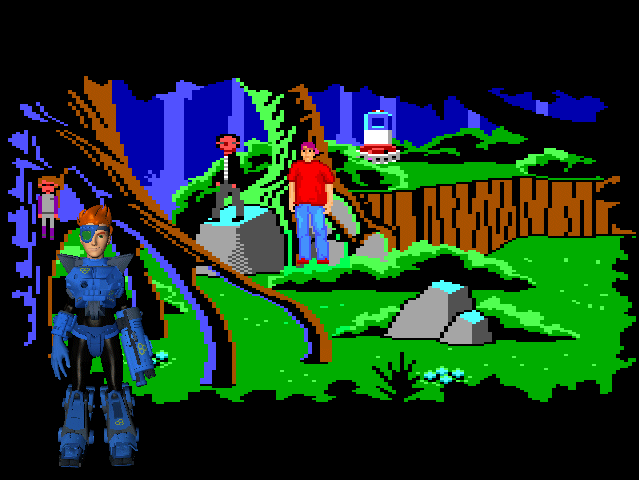
Early placeholder art (for the most part) of the game's inventory items. The pieces of evidence originally were inventory items, the pig sculpture was originally a cup with a picture of a pig on it, the length of silk originally needed to be combined with a bent metal rod to make a grappling hook, the ResAdjust device was originally a pair of goggles. The pig is still a cup at this stage, and, the item next to the perfume is the thermos filled strong coffee, originally used to stain the cup to make it look old.

I briefly considered having the game's Options, Save/Restore, Suspects and Glossary GUIs all be part of one huge GUI modelled after the original CommKey interface, but it turned out too busy, crowded and awkward.
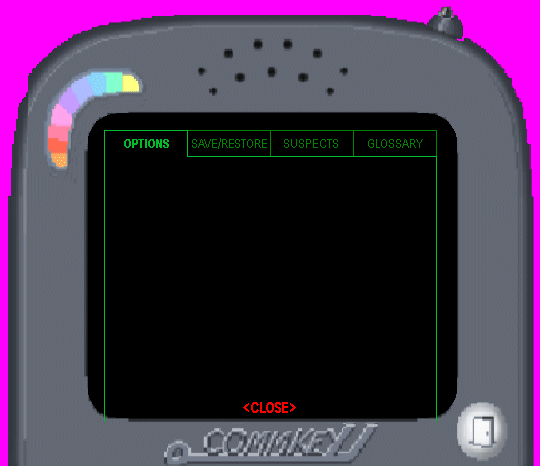
Early sketches of the Lasol crater and the intro sequence. This scene was originally going to be interactive and take place in an original game, and Thalia and her teammates were originally just going to be training in that game (since it was cancelled), not on an actual assignment.
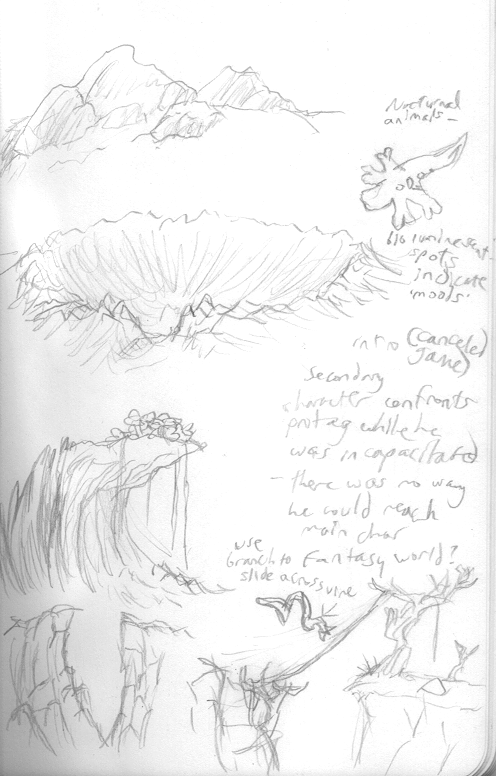
More sketches of the intro game that never made it past the concept stage.
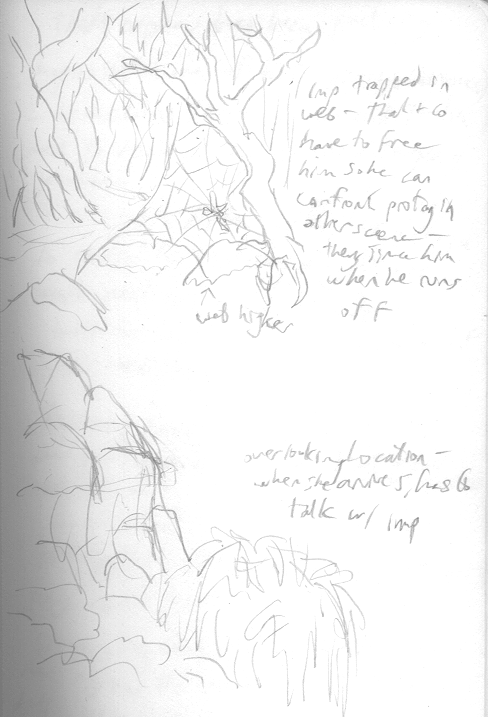
Sketches of the two construction sites -- the one with the castle and the one with the pits.
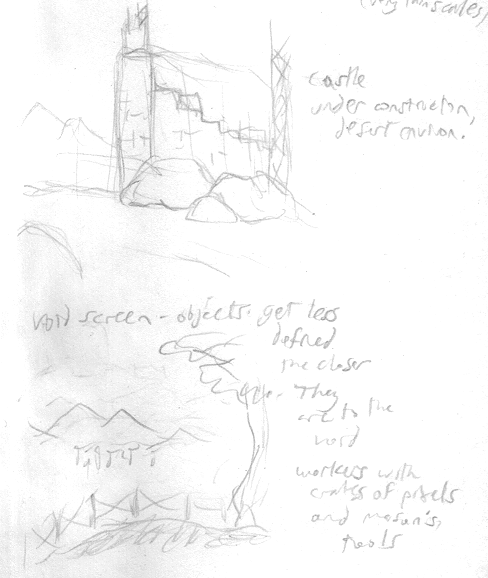
Rough storyboard of a scene from the climax (with some unrelated sketches in the bottom left corner).
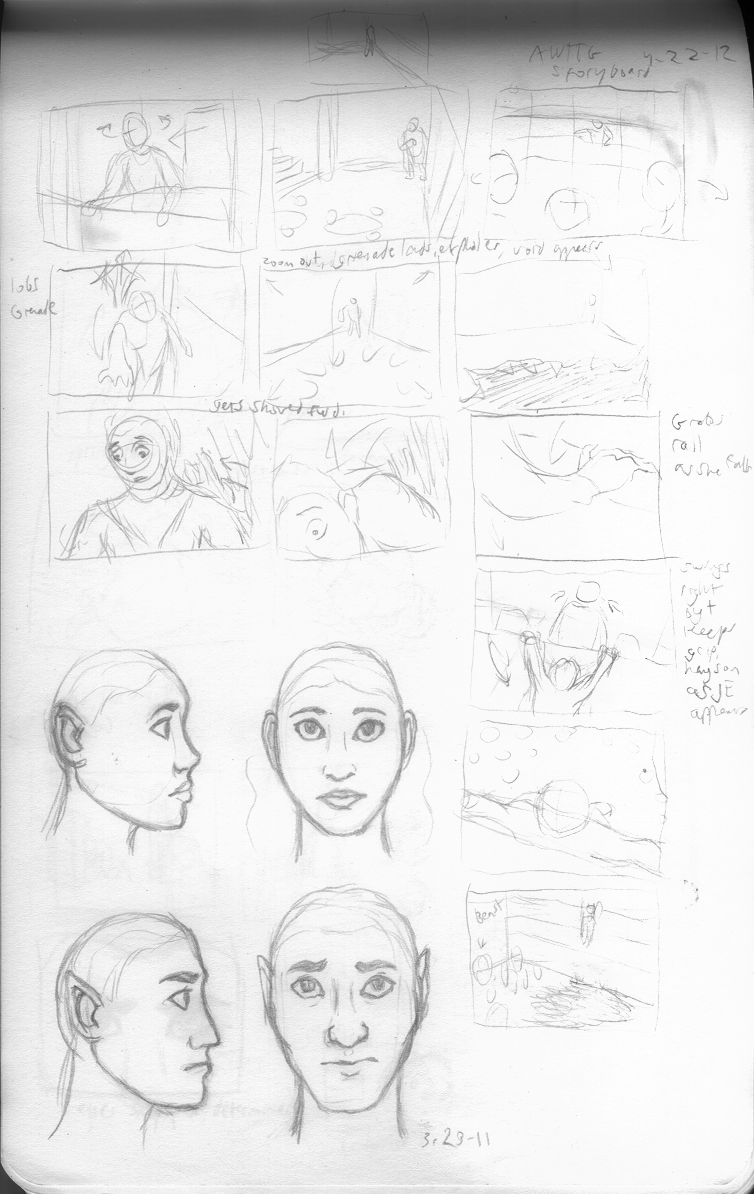
Rough storyboard of two of the scenes from the climax.

An unfinished version of the pits scene.
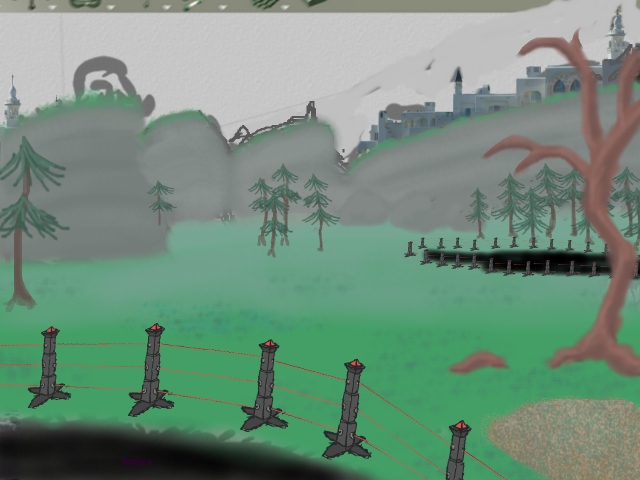
The icon bar glitched out after I saved the game and ended up looking like this.

Sketches of Suzy-Ann's room and the minigame.

An old version of the game's icon.

The Suspects and Glossary icons used to look like this and positioned on either side of the icon bar. I ended up moving them because they were a bit in the way and changed their looks because I thought were too busy compared to the other icons.


I found this spelling mistake I made oddly amusing. I meant to say "pocket". (And while I was typing this page up, I actually wrote "problem" instead of "pocket" in this description. I don't know what's wrong with me.)
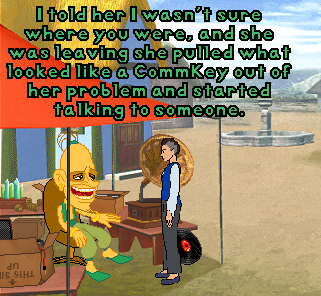
The dinosaur scene was originally going to take place in a two rooms featuring two floating islands connected by a bridge. I don't remember many of the details except that Thalia has to make it to her body before it walks off the edge of the island that it's on. I was thinking of digitally manipulating and painting over a photo of a model of the two islands I created out of clay, and I got about as far as that stage before deciding to scrap the whole thing.
![]()

A sketch of the unused islands, as well as a sketch of the gun Chu uses. The eagle-like creature may have been one of the obstacles between Thalia and her body.
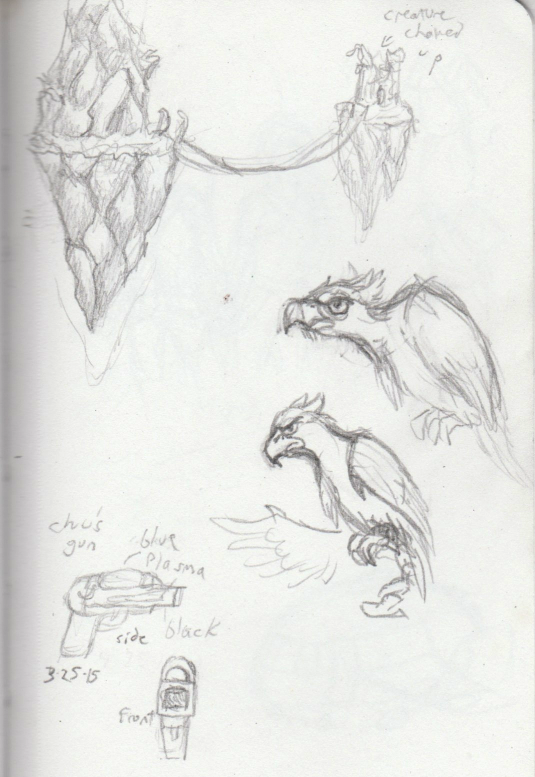
Suzy-Ann's unfinished 3D model, in Anim8or.
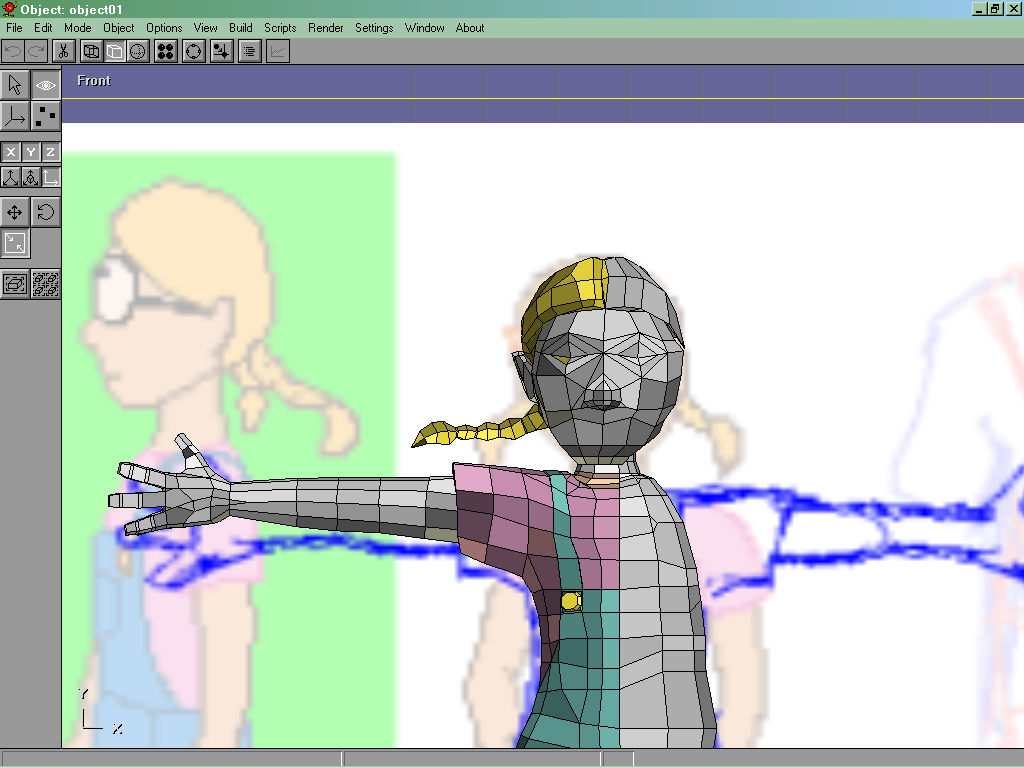
An unfinished version of the knickknack shop (4-22-13).

Sketches of the snowscape and desert scenes. The desert scene was created straight from the sketch, with few alterations besides the addition of color and erasing some of the linework.
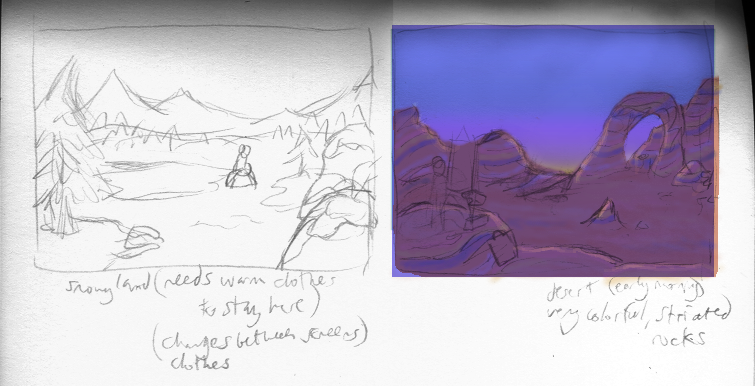
The woods in the Mega-Game were originally going to be at a higher resolution, but when I realized that there weren't that many EGA scenes in the Mega-Game, I decided to make the woods into an EGA scene. If you look very closely at the "Welcome to the Mega-Game!" billboard, you can see that a picure of the woods is there, but it's the hi-res version. An in-universe explanation for this would be that that's an early version the Designers decided to change ;)

Since I knew there would be a lot of stark contrast in the scene, I originally sketched the woods as a grayscale image.
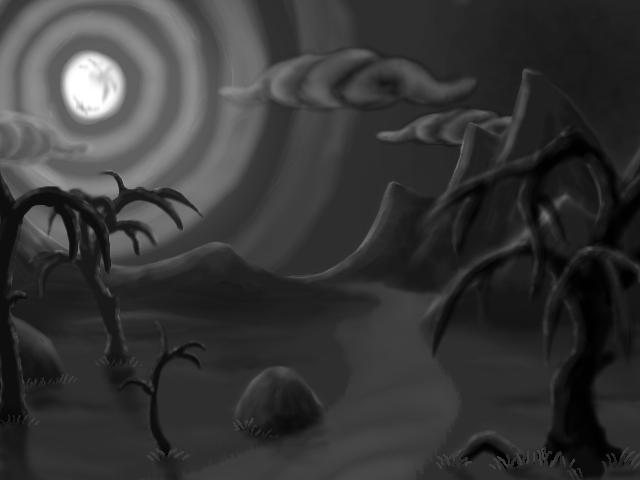
A very early version of the castle scene (8-2-12).
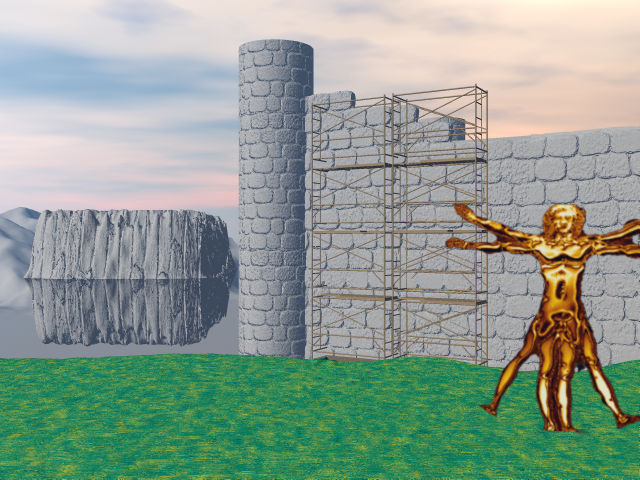
An early version of the south cliff scene.
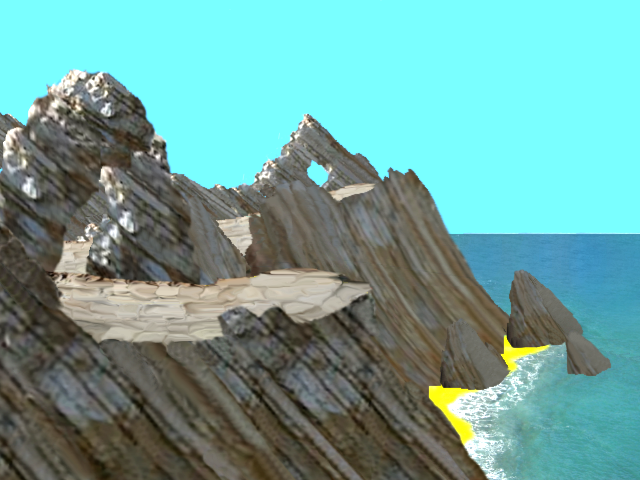
Here's what the back and front cover of the magazine lying on the floor of Sidonius' room look like up close (I intentionally blurred out the phone number):

Two screenshots of the theatre in the very early stages of its modelling (early 2012).
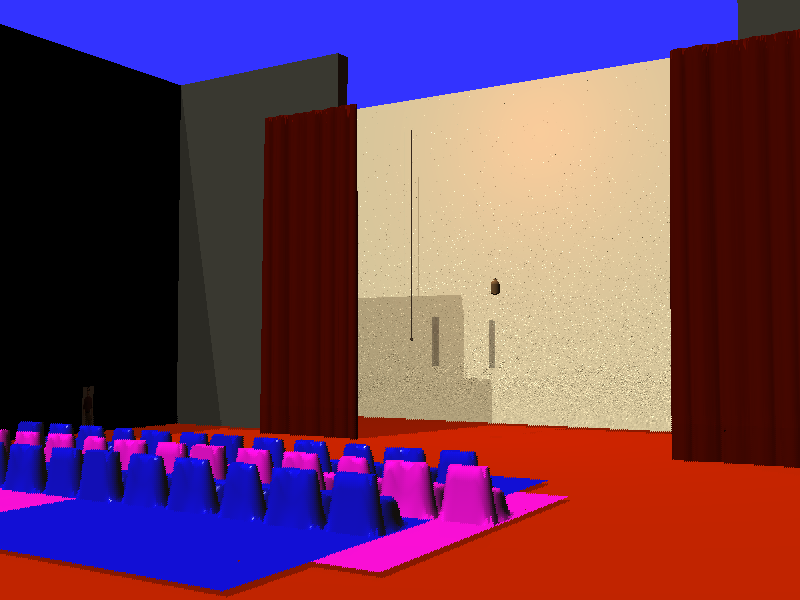
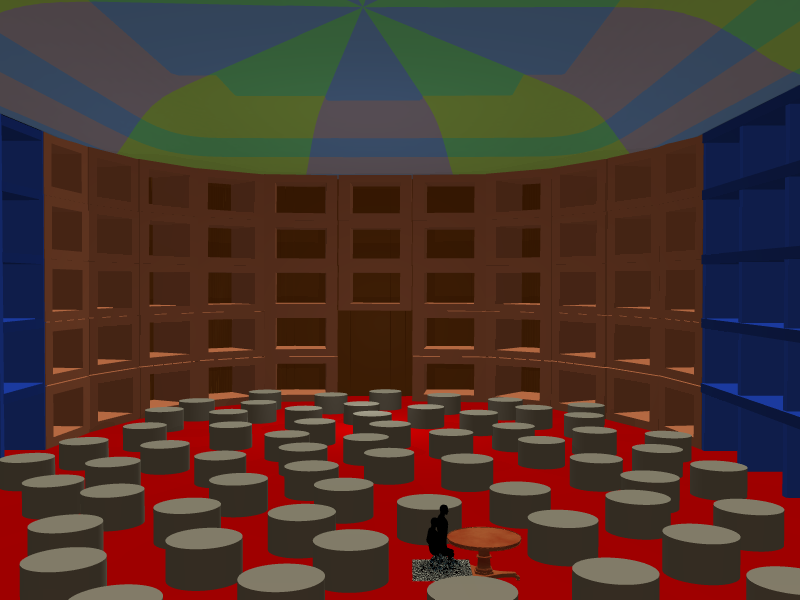
There was originally going to be a short cutscene when Thalia first arrived in the Mega-Game showing her looking around and the scene panning over to reveal the castle. I decided not to do this since it seemed like a bit too much work for too little payoff, plus I wasn't sure how I could pull off having two different Rooms appear "together".
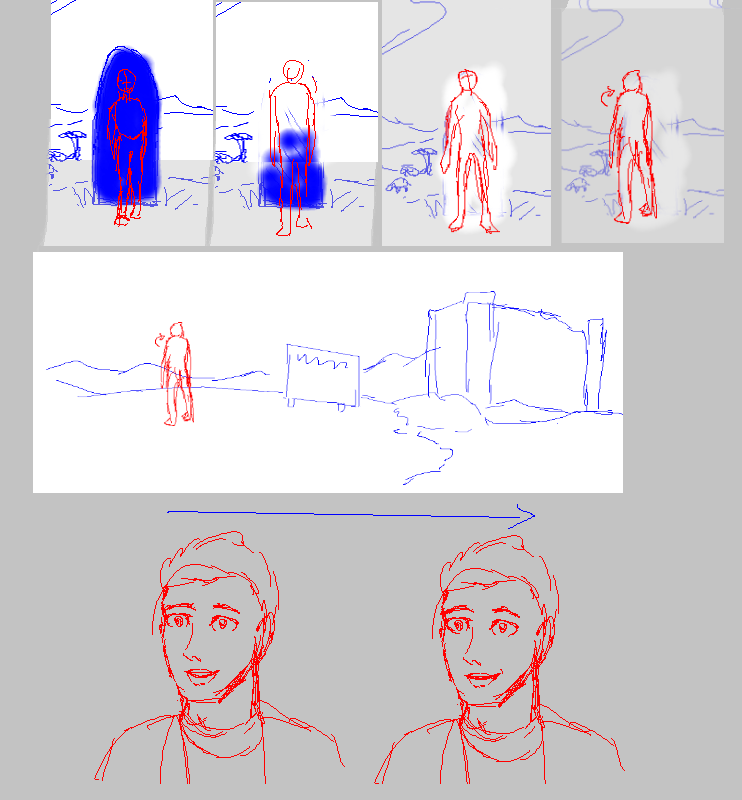
This is a sketch from 2007, before Adventure: The Inside Job was made. It's probably the very first sketch of Dylan, and the only big thing about his design that has changed since then is the alignment of his stripes. (Also, the "big cat with fingers trying to escape from lab" note alongside the sketches is a very simplified summary of my first game, Area 50.5.)
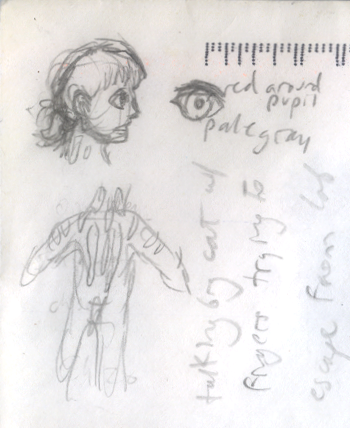
More sketches of Dylan from 2007 (these were the first sketches that featured his name).
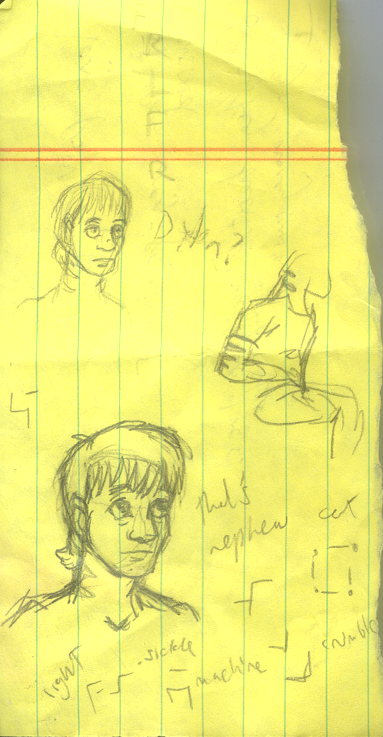
Sketches of LeMort and the jungle in the Mega-Game.
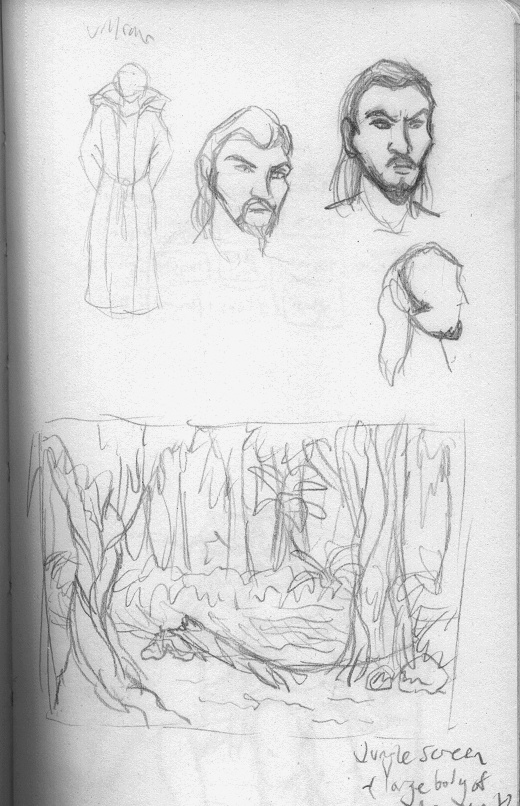
Digital sketch of the first Room of the Mega-Game.
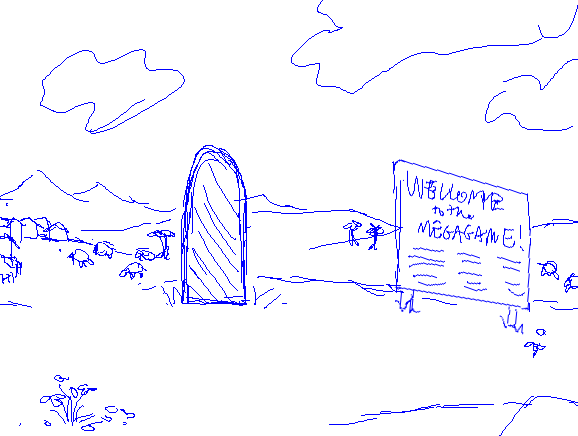
Digital sketch of the Room where the teleporter is found in the Mega-Game.
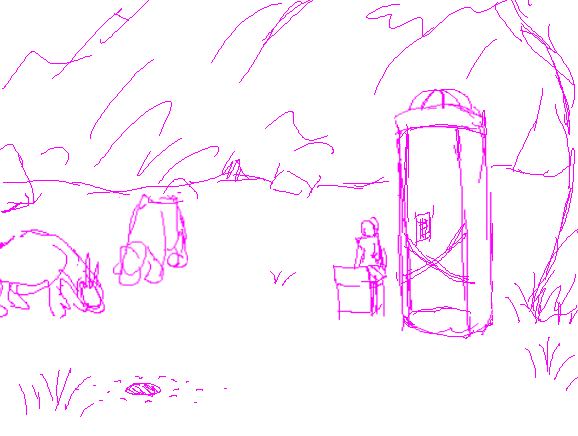
Digital sketch of the underwater cave in the Mega-Game.
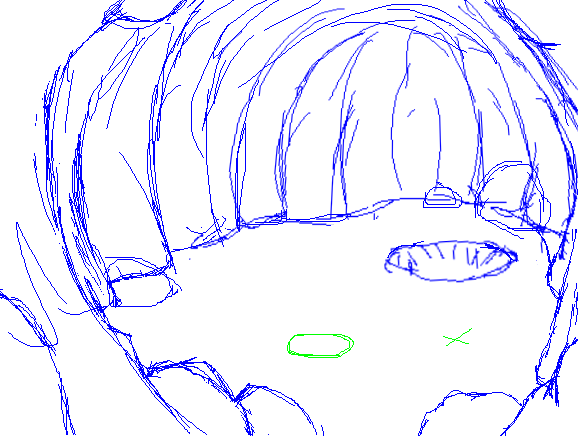
Early sketches of the shopkeeper and the archeologist.

Later sketches of the shopkeeper and the archeologist.
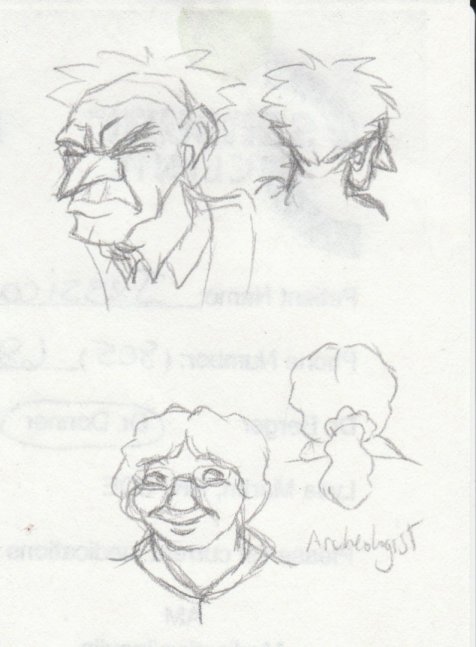
Some full-size versions of some of the archeologist's sprites.

Sketches of the Vertex's lobby and lounge.
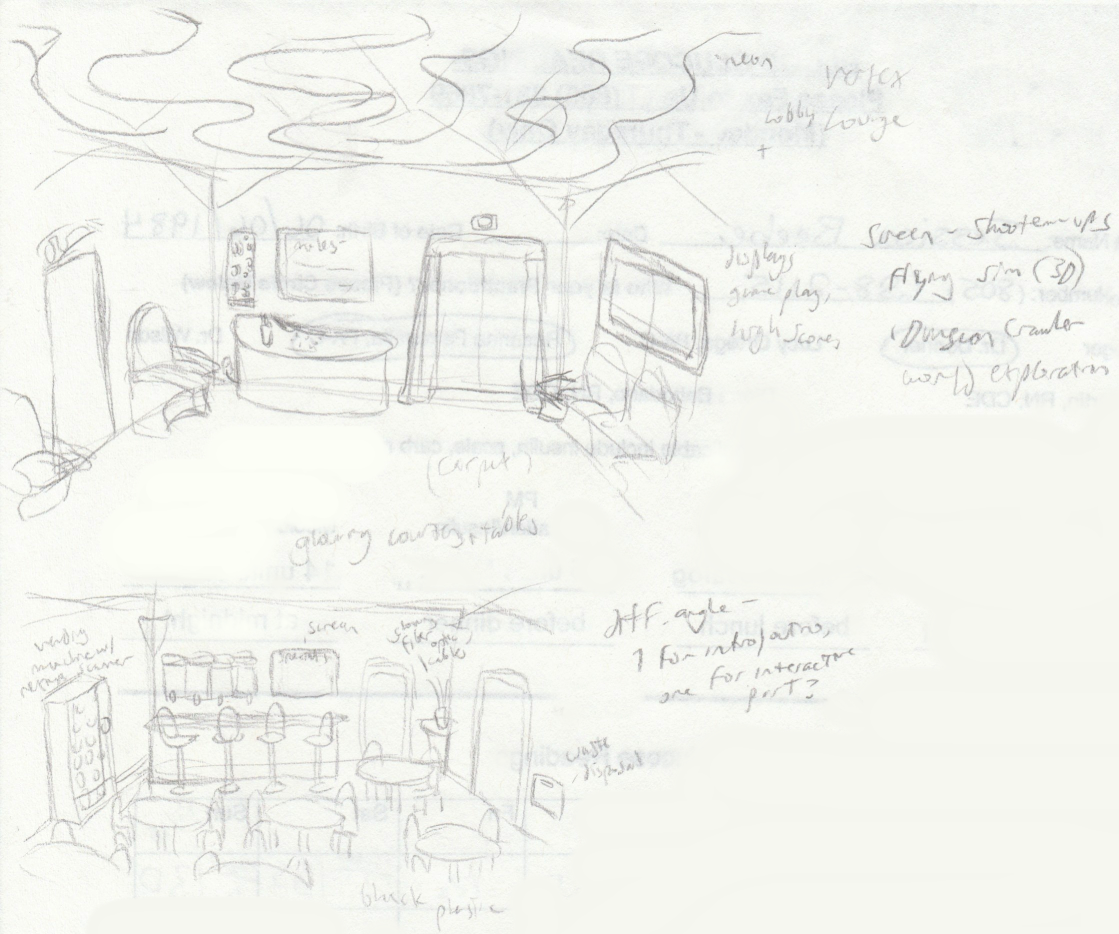
A sketch of the first scene on Lasol VII and the robot that guards the crater.
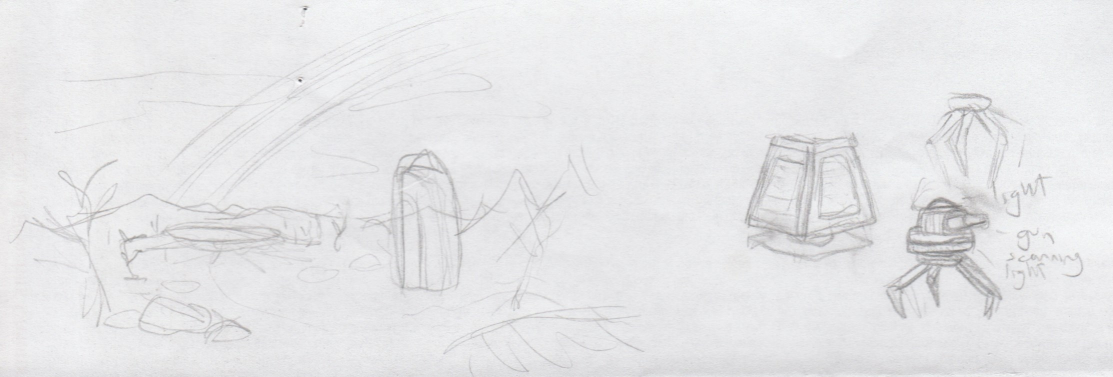
A sketch of the crater's rim and the base of the Cabal's elevator.A sketch of the crater's rim and the base of the Cabal's elevator.
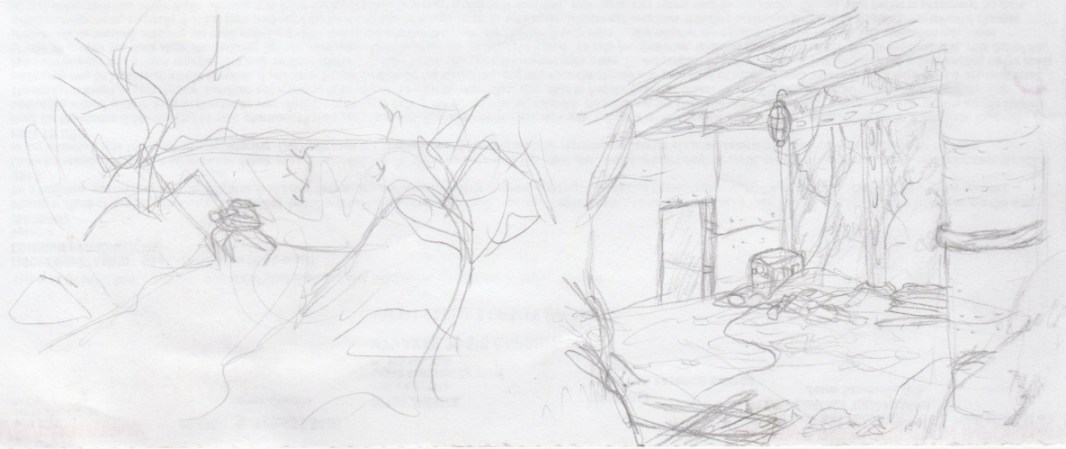
Early sketches of the Cabal's base.

Sketch of the base of the Cabal's elevator.
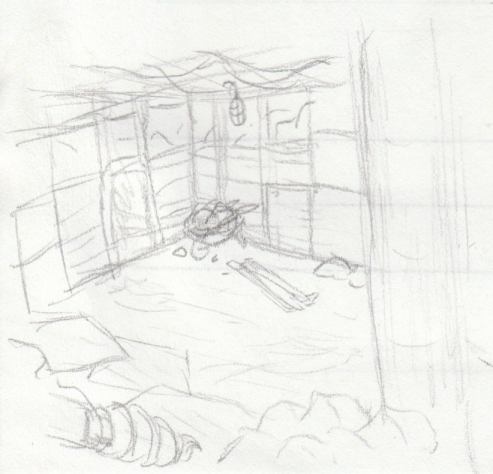
Sketches of LeMort's room.

Sketch of LeMort's fish from early 2015 which, unusually, was done in pen (since I had no pencils available at the time).

Sketches of the unnamed 3D room and Gus Greenbreeches from 2013 (who was originally more doglike, but became slightly more ratlike in the final game). As simple as his character model turned out, it was still quite a hassle to rig (as was Suzy-Ann's model), and I was glad that Chris Ushko was able to help me out in this area (thanks again, Chris!).
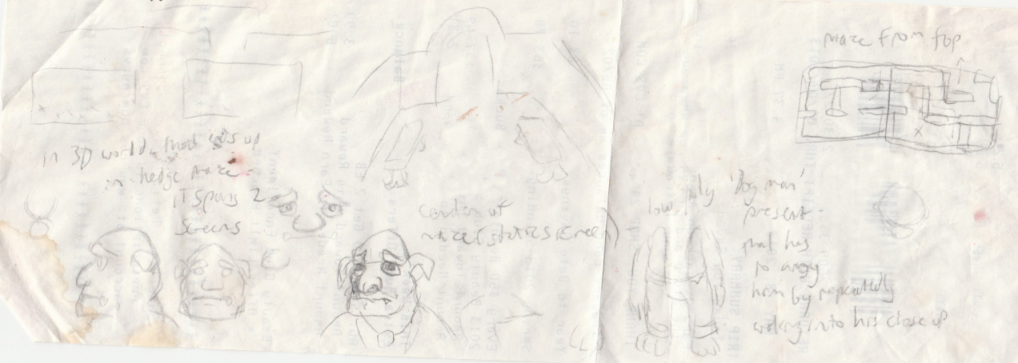
Early sketch of the valley where the theatre stands, as well as two sketches of the north cliff. (April 2014)
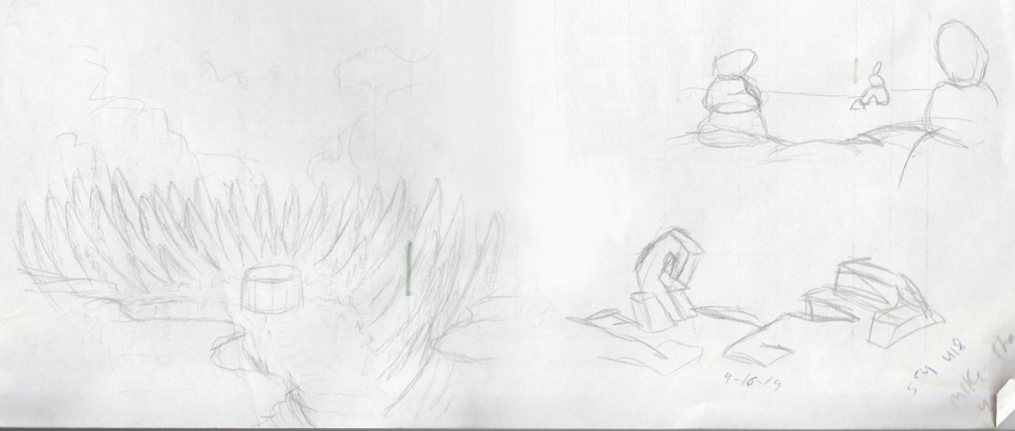
Sketches of Loamy. For a long time, he had no name or design, and I would just refer to him as "toady" in the game's notes. It seemed fitting that he should end up as a literal toad. I toyed with the idea of having a backstory of him coming from a cancelled fantasy game where he was a "defective" version of the Frog Prince who didn't fully transform into a man and joined up with LeMort in the hopes that LeMort could make him fully human again (or possibly fully toad).
I also toyed with the idea of him growing a spine and announcing his resignation from the Cabal to LeMort after realizing what LeMort's plan was, but it felt like I was piling too much detail on a character that didn't really need it (even though you can tell that he's grown less afraid of LeMort in the last scene he and LeMort appear in).
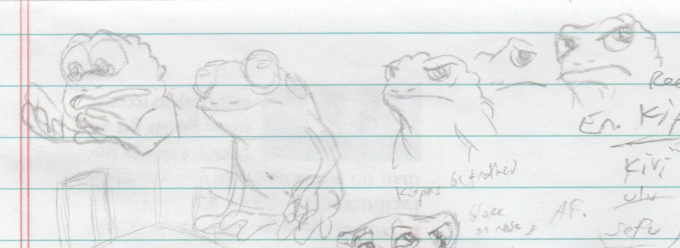
The kids' room in the Mega-Game was done in colored pencil with some digital retouching. I tried to take some photographs of it during its creation (my scanner was too small to fit the whole piece on) to document the process.

Early concepts of the scene of Thalia and Dylan talking, as well as some sketches of Dylan's gear and gadgets and a summary of the Space Quest 2 scene from the intro. (early 2015)
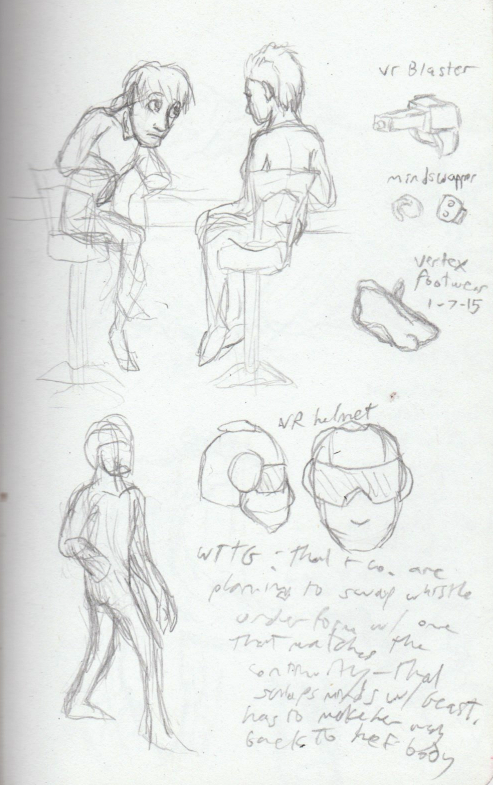
A sketch of Sparks Malarkey. (5-17-13)

Sketches of the theatre interior, the Vertex receptionist, and the top of the castle.

Sketch of Suzy-Ann's mirror and some concepts for the game's splash screen. The one on the left is similar to the final version with the puzzle pieces, but with images of common inventory items (a pencil, a key, a fish, a note) flying out of the open doorway.
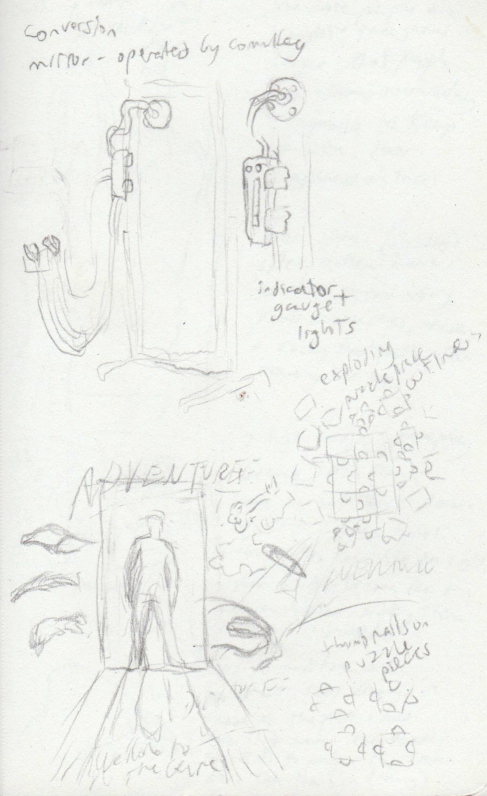
Sketches of various scenes in the Mega-Game (the text on the right reads "Too arid - should be more temperate; too many deserts" and "(puts torch between 2 close stalagmites)".

A reference sheet of the critter.
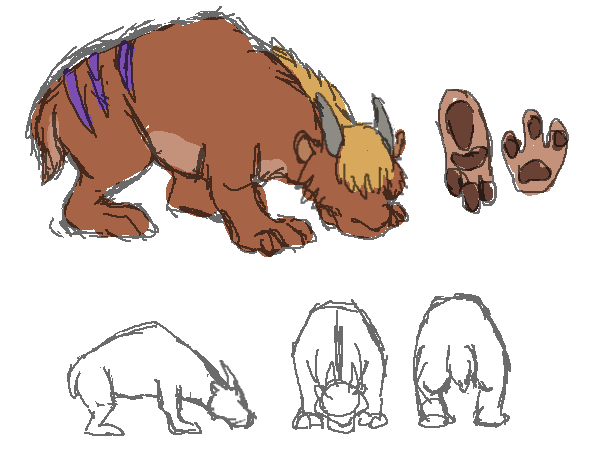
By the way: It's never obvious at any point in the game, but the critters have four eyes (just a random trait I decided to add to give them a more otherworldly appearance). They're just nearly impossible to see because of the hair that's covering their face. Here's a blown-up version of the one frame where they are visible:
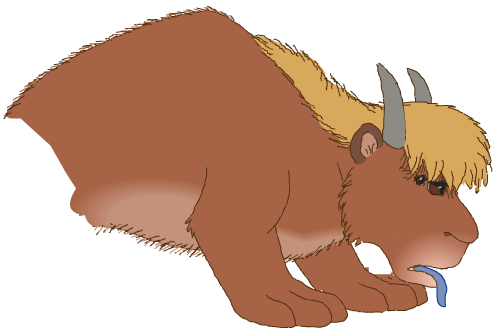
Development Journal
Back to Adventure: Welcome to the Genre

